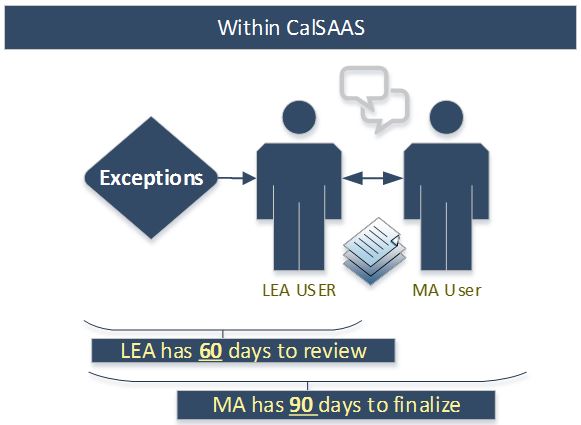Overview of CalSAAS
The California Statewide Assignment Accountability System (CalSAAS) is a new system of Assignment Monitoring allowing annual monitoring of all certificated educator assignments. The purpose of CalSAAS is to monitor certificated educator assignments in California, which satisfies the need for state and federal reporting requirements. The system automates the identification of questionable assignments, or “exceptions,” thereby allowing assignment monitoring of all certificated educator assignments to be completed annually without the cumbersome paper monitoring process of manually reviewing assignment records.
Function
CalSAAS works through the comparison of the California Department of Education’s California Longitudinal Pupil Achievement Data System (CALPADS) assignment data and the Commission’s Credential authorization data by educator’s California Statewide Educator Identifier (SEID). Through this comparison, the system identifies exceptions, and provides Local Educational Agencies (LEAs) and County Offices of Education with an opportunity to address anomalies, and correct verified misassignments.
After exceptions are identified, the LEA may review them and provide determinations for them. Determinations are the method used to justify why an exception was identified, (e.g. misassignment, vacancy, etc.). Determinations
can convey that an assignment is appropriate, or that it is, in fact, a misassignment.
Note: Any exception left undetermined by the close of the monitoring cycle will be considered a misassignment, and reported as such. Determinations in place at the close of the monitoring cycle will be unchanged when data is finalized.
The exceptions will move through a monitoring progression. First, the LEA may review the exceptions, select a determination, and submit them to their Monitoring Authority (MA) along with justification via text within the comment box and, if appropriate, upload additional documentation. After the LEA addresses an exception, the MA is able to review it. If the MA approves, it can leave the determination as is. If the MA requires more information, they can return the exception to the LEA and request further clarification.
Timeline
Census date
The comparison occurs with data collected on CDE’s CALPADS Fall 2 Census date. CDE collects data annually, on the first Wednesday in October. You may find the CALPADS data collection calendar here for a schedule of annual data collection.
For assignment monitoring purposes, the census date is considered a snapshot in time. Educator Assignment records on that date are used for comparison in CalSAAS. Therefore, any educator that does not hold an appropriate credential for their assignment on this date will generate an exception.
Because of this:
- any classrooms reported without teachers of records (via a placeholder 999 SEID number) will be predetermined as vacancies, which are misassignments; and
- any assignment reportedly filled by an uncredentialed educator, substitute permit holder, or TPSL holder cannot be teachers of records, and reporting them in CALPADS would generate an exception.
Also note that if you have a substitute teacher in the classroom on this date, the teacher of record should be reported in CALPADS. Refer to the Reporting Substitute Assignments in CalSAAS webpage.
CDE maintains an extended submission window, and certifies the data that is submitted. Because of this, historically the Commission has received CDE’s assignment data in the Spring. At this point, the Commission interfaces that data with its educator certification records, and releases the resulting exceptions through CalSAAS.
Exception Timeline
Once exceptions are released in CalSAAS, they are available within the system for 90 calendar days. Users representing LEAs will have 60 calendar days to review and determine exceptions, after which their initial review window will be closed. However, LEAs will still be able to modify exceptions that have been returned to them from their MA for 30 calendar days after their initial 60-day review window has closed.
Monitoring Authorities have access to exceptions during the duration of the 90 calendar days, and can review the determinations LEAs are providing in real time. However, if they prefer to wait until the LEA provides all determinations, the final 30 days is reserved for their review.
Beyond identifying exceptions, CalSAAS also provides a communication platform for MAs and LEAs related to potential misassignments. During this 90-day period, users are able to discuss assignments, provide context, and upload supporting documentation.
.png?sfvrsn=c28b72b1_10)
.png?sfvrsn=cd8b72b1_0)

